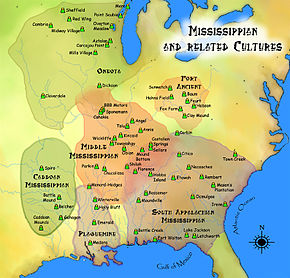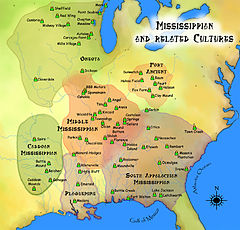- Oneota
-
For the neighborhood in Duluth, Minnesota, see Oneota (Duluth).
Oneota is a designation archaeologists use to refer to a cultural complex that existed in the eastern plains and Great Lakes area of what is now the United States from around AD 900 to around 1650 or 1700. The culture is believed to have transitioned into various Macro-Siouan cultures of the protohistoric and historic times such as Ioway. A long-accepted ancestry to the Ho-chunk has yet to be conclusively demonstrated.
Oneota is considered a major component of Upper Mississippian culture. It is characterized by globular, shell-tempered pottery that is often coarse in fibre. It often had a spherical body, short necks and/or a flat lip. Sometimes the vessels had strap handles. Decoration includes wavy and zigzag lines, often in parallel. Most decoration was done on the top half of the vessel.[1] Analytically, it has been broken down into various stages or horizons. Generally accepted are the following: the Emergent Horizon (ca. AD 900-1000), the Developmental Horizon (ca. AD 1000-1300), the Classic Horizon (ca. AD 1300-1650) (previously called the Oneota Aspect), and the Historic Horizon (post-contact, generally after 1650). In addition, the Oneota culture has been divided geographically based on stylistic and socio-economic differences. Some of these traditions are Orr, Langford, and Fisher-Huber. Oneota pottery was made in a distinctive globular form.
The Oneota diet included corn, beans, and squash, wild rice, nuts, fish, deer, and bison, varying according to the region and locale.
Relationships with Middle Mississippian were present but are not yet clearly understood. Whether Oneota developed in situ out of Late Woodland cultures, was invasive, was the result of influence from (proto-)Middle Mississippian peoples, or was some mix of these is not clear.
Contents
See also
Sources
- Gibbon, Guy E. 1982 Oneota Studies.
- Green, William (ed.) 1995 Oneota Archaeology: Past, Present, and Future.
References
- ^ Behm, Jeffrey (2007 April) Oneota Tradition. University of Wisconsin-Oshkosh. Oshkosh, WI
External links
- Uiowa.edu, general material and large annotated bibliography
- Angelfire.com, updated bibliography
- The Oneota Culture Prehistoric Farmers of the American Midwest; By K. Kris Hirst, About.com
- Mississippian and Oneota Traditions
- Oneota, Minnesota State University-Mankato
 Pre-Columbian North America
Pre-Columbian North AmericaArchaeological cultures North American pre-Columbian chronology – Adena – Alachua – Ancient Pueblo (Anasazi) – Baytown – Belle Glade – Buttermilk Creek Complex – Caborn-Welborn – Calf Creek – Caloosahatchee – Clovis – Coles Creek – Deptford – Folsom – Fort Ancient – Fort Walton – Fremont – Glades – Glacial Kame – Hopewell (List of Hopewell sites) – Hohokam – Leon-Jefferson – Mississippian (List of Mississippian sites) – Mogollon – Monongahela – Old Cordilleran – Oneota – Paleo-Arctic – Paleo-Indians – Patayan – Plano – Plaquemine – Poverty Point – Prehistoric Southwest – Red Ocher – Santa Rosa-Swift Creek – St. Johns – Steed-Kisker – Tchefuncte – Tocobaga – Troyville
Archaeological sites Angel Mounds – Bandelier National Monument – The Bluff Point Stoneworks – Cahokia – Chaco Canyon – Casa Grande – Coso Rock Art District – Eaker – Effigy Mounds National Monument – Etowah Indian Mounds – Eva – Folsom Site – Fort Ancient – Fort Center – Gila Cliff Dwellings National Monument – Holly Bluff Site – Hopewell Culture National Historical Park – Kincaid Mounds – Kolomoki – Manitou Cliff Dwellings – Marksville – Meadowcroft Rockshelter – Mesa Verde – Moorehead Circle – Moundville – Mummy Cave – Nodena Site – Ocmulgee National Monument – Old Stone Fort – Parkin Park – Pinson Mounds – Portsmouth Earthworks – Poverty Point – Pueblo Bonito – Rock Eagle – Rock Hawk – Salmon Ruins – Serpent Mound – Spiro Mounds – SunWatch – Taos Pueblo – Toltec Mounds – Town Creek Indian Mound – WintervilleMiscellaneous Ballgame – Black drink – Buhl woman – Calumet – Chunkey – Clovis point – Container Revolution – Eastern Agricultural Complex – Eden point – Effigy mound – Falcon dancer – Folsom point – Green Corn Ceremony – Horned Serpent – Kennewick man – Kiva – Metallurgy – Mi'kmaq hieroglyphic writing – Medicine wheel – Mound builders – N.A.G.P.R.A. – Norse colonization of the Americas – Piasa – Pueblo dwellings – Southeastern Ceremonial Complex – Three Sisters agriculture – Thunderbird – Underwater panther
Categories:- Prehistory
- Native American history
- Mississippian culture
- Archaeology of the United States
- United States archaeology stubs
Wikimedia Foundation. 2010.



